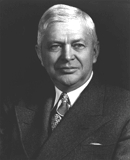.jpg)
If you were awake this morning around 8 a.m. eastern time (5 a.m. Pacific), you may have heard what sounded like a clutch giving out; a great grinding sound that didn’t come from any location outside your window; it was an overall thing, disembodied, everywhere at once.
What you no doubt heard was the 100-year-old business model of General Motors — once the world’s pre-eminent industrial icon, a corporate behemoth bestriding the globe — finally collapsing by way of the ruling of a New York judge who approved the terms of what is, as ranked by total assets, the fourth-largest industrial bankruptcy in American history.
 After years of running in the redline — with not enough attention paid to a changing global market, not enough initiative to change a moribund corporate bureaucracy, not enough sensitivity to consumer demands, not swift enough focus on retooling for a world desperate for alternatives to fossil fuels — GM ground to a screeching halt as an independent company.
After years of running in the redline — with not enough attention paid to a changing global market, not enough initiative to change a moribund corporate bureaucracy, not enough sensitivity to consumer demands, not swift enough focus on retooling for a world desperate for alternatives to fossil fuels — GM ground to a screeching halt as an independent company. This morning, a few hours after the breakdown, President Obama took possession, announcing that the new 60% majority owner of the company — assets of $82.3 billion, liabilities of $172.8 billion — was the United States of America.
◊ ◊ ◊
"We are acting as reluctant shareholders, because that is the only way to help GM succeed," Obama said. "What we are not doing — what I have no interest in doing — is running GM. They, and not the government, will call the shots and make the decisions about how to turn this company around. …
“Working with my auto task force, GM and its stakeholders have produced a viable, achievable plan that will give this iconic American company a chance to rise again," the president said.
“It's a plan tailored to the realities of today's auto market; a plan that positions GM to move toward profitability, even if it takes longer than expected for our economy to fully recover; and it's a plan that builds on GM's recent progress in making better cars. As this plan takes effect, GM will start building a larger share of its cars here at home, including fuel-efficient cars. In fact, if all goes according to plan, the share of GM cars sold in the United States that are made here will actually grow for the first time in three decades."
It’s not a painless plan. In his survey of those with skin in the game, Obama again summoned his ability to impart the narrative of shared sacrifice and collective responsibility that has been a hallmark of his presidential style from the beginning.
“It will require the United Auto Workers to make further cuts in compensation and retiree health care benefits -- painful sacrifices on top of all that they have already done.
“It will require GM shareholders to give up the remaining value of their shares — just as they would have had to do in any private restructuring of this kind.
“And it will also provide unsecured bondholders with an equitable outcome — an outcome that will let them recover more than the current value of their claims, and substantially more than they would have recovered if the government had not intervened and GM had liquidated.”
◊ ◊ ◊
The collateral fallout of course stretches beyond those affected at the corporate offices, at Renaissance Center in Detroit. This corporate vivisection ultimately and more widely comes down to the people working at the plants, or those who used to work there, or those who soon will “used to” work there.
Plant closings announced include assembly plants in Pontiac, Mich., and Wilmington, Del.; stamping plants in Grand Rapids, Mich., Indianapolis and Mansfield, Ohio; and powertrain plants in Livonia, Flint and Willow Run, Mich., Parma, Ohio, and Fredericksburg, Va.
Visit msnbc.com for Breaking News, World News, and News about the Economy
The company said it has plans to close 17 factories and parts centers and cut 20,000 more jobs by the end of 2011 in at least five states. GM's parts division announced today that operations at parts distribution centers in Boston; Columbus, Ohio; and Jacksonville, Fla., would be shuttered by year’s end.
“I will not pretend the hard times are over," the president and CEO of the Uncle Sam Automobile Company said, in comments clearly meant for GM employees. "More jobs will be lost. More plants will close. More dealerships will shut their doors, and so will many parts suppliers.
"But I want you to know that what you're doing is making a sacrifice for the next generation . . . so that your children and all of our children can grow up in an America that still makes things, that still builds cars, that still strives for a better future."
◊ ◊ ◊
But more than that, bigger than the numbers and high-flown executive-suite plans is the other damage this bankruptcy, however short-lived, does to our storied industrial knowhow, that indomitable sense of spirit that’s animated and nurtured the national economy for most of our lives. That existential endowment we shared as Americans. That license to a journey that begins behind the wheel. That maverick birthright, that singular experience: the right to own and drive a car. An American car.
Dan Neil, writing in the Los Angeles Times, pretty much nailed it today:
“If you were to walk up to a typical New York executive in the 1960s — think Don Draper in AMC's "Mad Men" — and tell him that General Motors Corp. would be in bankruptcy by 2009, he would have thought you were delusional, or perhaps a Communist. GM was more than just the world's largest and most admired corporation; it was the final vindication of the American Way, the perfected and even divinely inspired example of democratic capitalism …”
◊ ◊ ◊
 With a confidence we should be used to by now, President Obama today borrowed the words of former General Motors CEO Charles E. Wilson, who in 1953 brazenly juxtaposed the national interest with that of GM during his confirmation hearings to be Secretary of Defense, which he was under Eisenhower.
With a confidence we should be used to by now, President Obama today borrowed the words of former General Motors CEO Charles E. Wilson, who in 1953 brazenly juxtaposed the national interest with that of GM during his confirmation hearings to be Secretary of Defense, which he was under Eisenhower. Obama today expressed confidence that the “new GM” will be able to “out-compete automakers around the world” and eventually usher in that frabjous day when a newer, leaner, downsized, hybridized GM returns to pre-eminence, and profitability.
“And when that happens,” the president said, invoking Wilson, “we can truly say that what is good for General Motors and all who work there is good for the United States of America.”
We can’t wait for the economy and the market to catch up to the president’s confidence. The near future isn’t much to look forward to. Next Monday, GM will be delisted from the Dow Jones Industrial Average, the first absence of GM on the Big Board in about 84 years.
And today, this Monday, the common stock of General Motors — corporate titan, dowager of business, model of the American industrial age — closed at 75 cents a share.
-----
Image credits: Obama announcement: Samantha Appleton, The White House. General Motors logo: General Motors. Charles Wilson: Department of Defense (public domain).






No comments:
Post a Comment